A lifelong collection of beer stein knowledge.
-
![Some of the Beauties of the Westerwald [2]: “Ring Jugs” – Really, What Are the Definitions? A Brief Discussion. New: 4-20-13](https://www.steveonsteins.com/wp-content/uploads/2013/04/WEST-DOUBLE-RING-JAR-WITH-GNOMES-DIFFERENT-FROM-OTHER-THIS-IDIOT-WANTED-OVR-200-FOR-SHIPPING.1.jpg)
Some of the Beauties of the Westerwald [2]: “Ring Jugs” – Really, What Are the Definitions? A Brief Discussion. New: 4-20-13
This discussion started with this email from a reader and new collector in mid April 2013: Steve: Your new page on “Ring Jugs” has piqued my interest regarding the ring in beak motif of the Ringkrug. I would like to hear what you have found. I’m a newbie, but prior to reading your page I had…
-
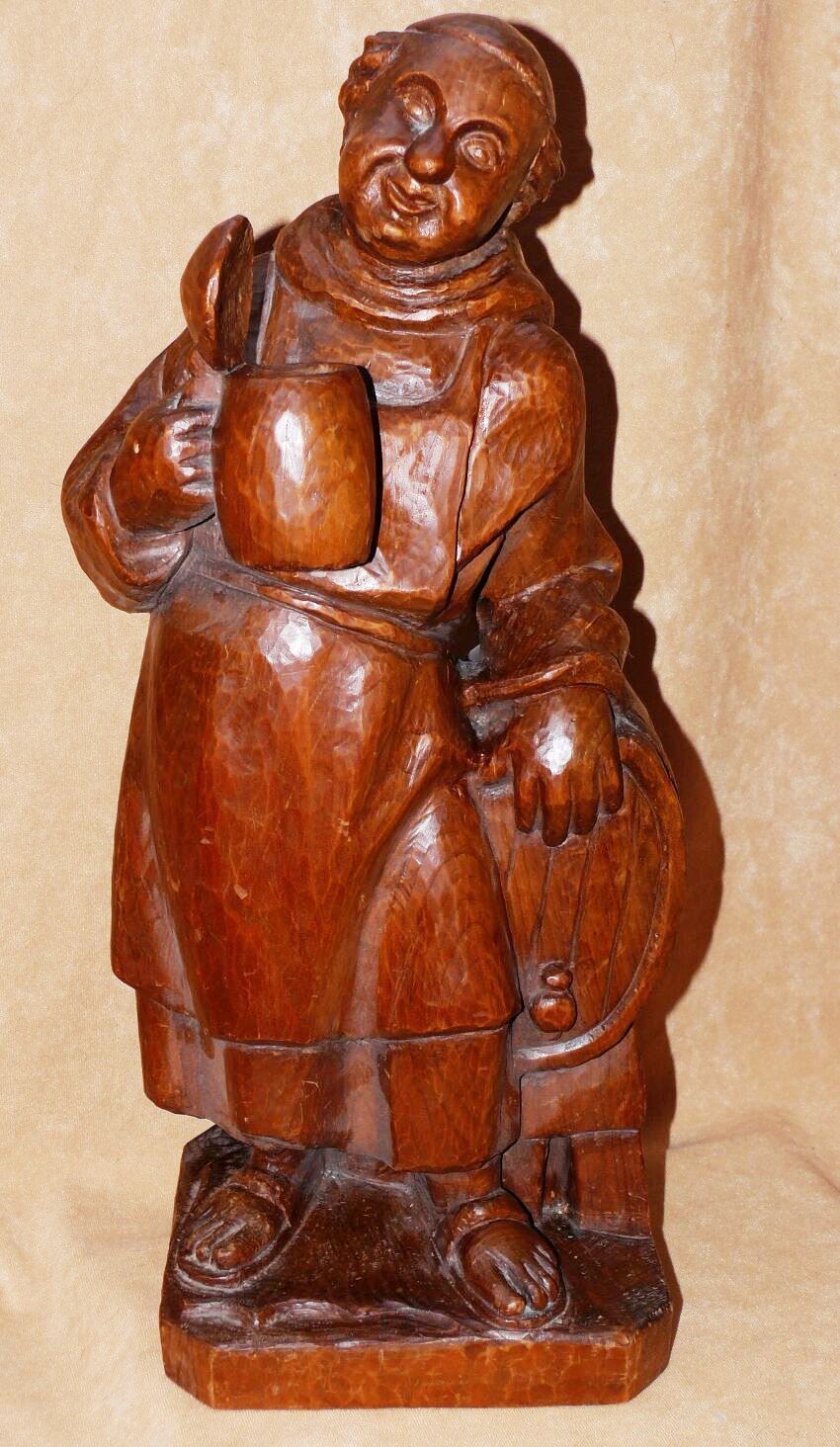
“Roll Out The Barrel – We’ll Have a Barrel of Fun Page 1 – “
As nice as this German carving of a monk and his beer stein is , one can always fine another version done by a person who just should have stayed in bed that day. As in – see next example below ▼. . ABOVE ▲ .FOLK ART CARVING FROM ROMANIA. I OFTEN WONDER WHO BOUGHT THIS…
-
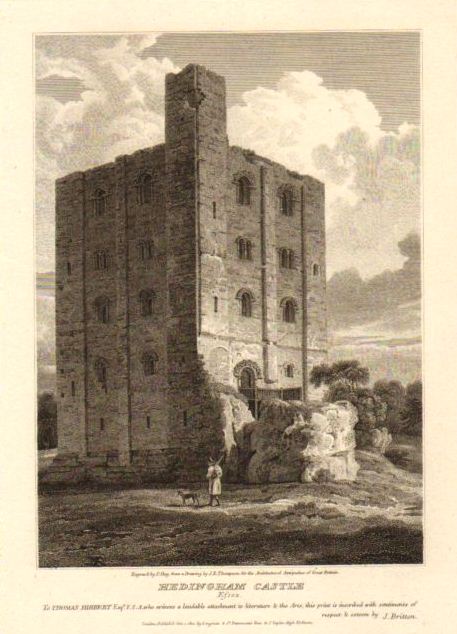
A Couple Dozen (Well, Maybe A Few More) of Well Known and Collectable “Castle Hedingham” (England) Medieval Style Pottery Drinking Vessels by E. Bingham
The Castle Hedingham – Circa 1810. Castle Hedingham ware tyge / pass cup. For more info on “Pass Cups” please see: http://www.steveonsteins.com/pass-cups-a-short-history-new-12-26-10 Castle Hedingham was an art pottery studio founded by Edward Bingham at Castle Hedingham in Essex, England in production from 1864 to 1901 and made in a style reminiscent of medieval and Tudor…
-
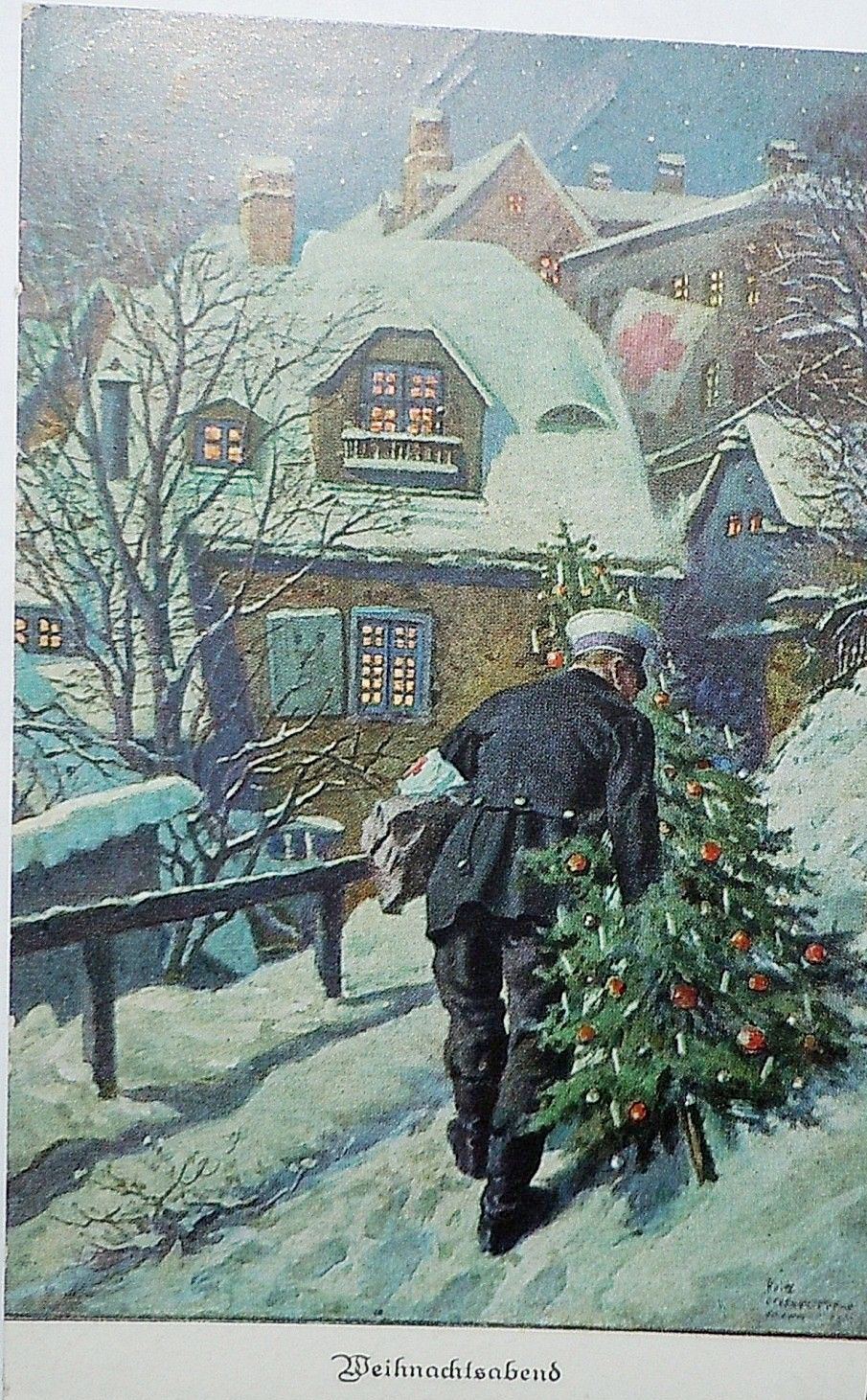
Artillery shell character steins (or) “Let’s just blow the shit out of each other the whole year long, but sing ‘Merry Christmas’ on one day of the year, okay?”
Now, is this not a happy scene? A nice Christmas Tree for the boys that have been blown apart in the trenches during WWI! For an even more “makes me want to puke! ” video produced in 2014 by Sansbury’s (an English food firm) trying to be politically correct 100 years later!! https://www.youtube.com/watch?v=NWF2JBb1bvM&feature=youtu.be No need for me to…
-
![Guest writer’s articles: “Identifing Faience Steins [Part 7] – Crailsheim (1715-1827) Fayence (Germ.) Beer Steins” – by William Hamer (NEW 1-30-13)](https://www.steveonsteins.com/wp-content/uploads/2013/01/BH7-13-RDY.jpg)
Guest writer’s articles: “Identifing Faience Steins [Part 7] – Crailsheim (1715-1827) Fayence (Germ.) Beer Steins” – by William Hamer (NEW 1-30-13)
(Courtesy of Ron Fox. No. 13 ) Editor’s note: This article and the others in this series were originally published in PROSIT, the magazine of Stein Collector’s International. Used with permission of the author, Bill Hamer, a long term good friend of mine; and from Ron Fox, the editor of “PROSIT.” IDENTIFYING FAIENCE STEINS –…
-
![Guest writer’s articles: “Identifing Faience Steins [Part 6] – Magdeburg Fayence (Germ.) Beer Steins” – by William Hamer (NEW 1-30-13)](https://www.steveonsteins.com/wp-content/uploads/2013/01/026-2-400x792-1.jpg)
Guest writer’s articles: “Identifing Faience Steins [Part 6] – Magdeburg Fayence (Germ.) Beer Steins” – by William Hamer (NEW 1-30-13)
Magdeburg stein, new in “FWTD”, January 2013 Note: This article and all the others in this series were originally published in “PROSIT,” the magazine of Stein Collector’s International. Used with permission of the author Bill Hamer, a long term good friend of mine; and from Ron Fox, the editor of “PROSIT.” IDENTIFYING FAIENCE STEINS –…
-
![Some of the Beauties of the Westerwald [1]: Very Large 19th Century Wine & Beer Jugs from the Westerwald and Regensburg.](https://www.steveonsteins.com/wp-content/uploads/2013/01/A-nteresting-trade-sign-STONEWARE-jugs-outside-flavours_.jpg)
Some of the Beauties of the Westerwald [1]: Very Large 19th Century Wine & Beer Jugs from the Westerwald and Regensburg.
Before reading the article below- please avail yourself of an excellent dissertation on the subject of the Westerwald at John McGregors site: http://www.thepatriotexchange.com/pss/wester.htm CIRCULAR JUGS OF THE WESTERWALD, (KANNENBÄCKERLAND) AND THE REGENSBURG AREA: NOTES: [1] Historismus – A “time period” term used to define those steins and vessels designed (and produced) based largely on the old…
-
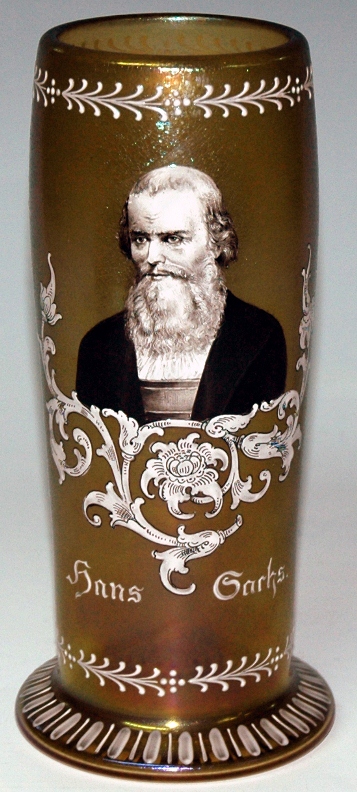
The “Nurnberg Tricher,” its “Funnel Man” and Its Relationship to the “The Minnesingers” and “The Meistersingers.”
A F. Heckert enameled “Humpen” of Franz Sachs. About 10 inches tall. (D.H.) Dietmat von Aist (Codex Manesse.) Dietmar von Aist was a Minnesinger from a baronial family of Upper Austria, documented between 1140 and 1171, whose work is representative of the lyric poetry of the Danube region. THE MINNISINGER – THESE ARE THE SINGERS WHO…
-
![Guest writer’s articles: “Identifing Faience Steins [Part 5] ‘Erfurt Fayence (Germ.) Beer Steins” – by William Hamer](https://www.steveonsteins.com/wp-content/uploads/2012/09/ER-Figure-1.jpg)
Guest writer’s articles: “Identifing Faience Steins [Part 5] ‘Erfurt Fayence (Germ.) Beer Steins” – by William Hamer
Note: This article and all the others in this series were originally published in “PROSIT,” the magazine of Stein Collector’s International. Used with permission of the author Bill Hamer, a long term good friend of mine; and from Ron Fox, the editor of “PROSIT.” IDENTIFYING FAIENCE STEINS – PART 5 ERFURT (1717-1792) By William Hamer…
-
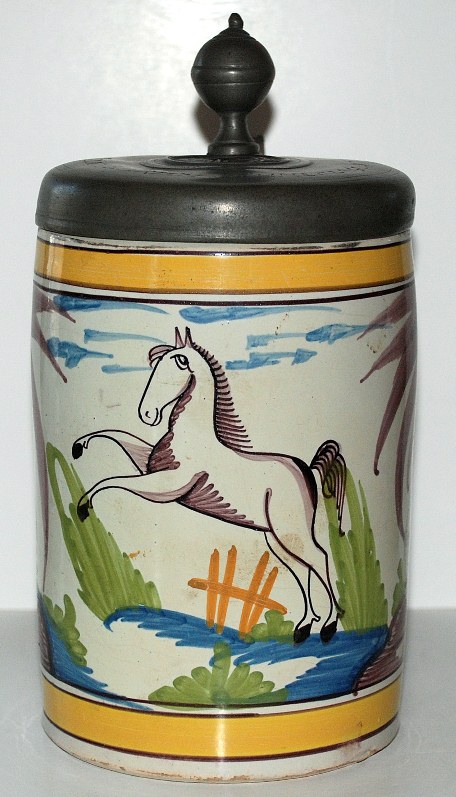
Guest writer’s articles: “Identifing Faience Steins [Part 4): “Hannoversch-Munden Fayence (Germ.) Beer Steins” – by William Hamer
READERS Note: This article and all the others in this series were originally published in “PROSIT,” the magazine of Stein Collector’s International. Used with permission of the author Bill Hamer, a long term good friend of mine; and from Ron Fox, the editor of “PROSIT.” IDENTIFYING FAIENCE STEINS – PART 4; HANNOVERSCH-MUNDEN (1732-1806) by William…
-
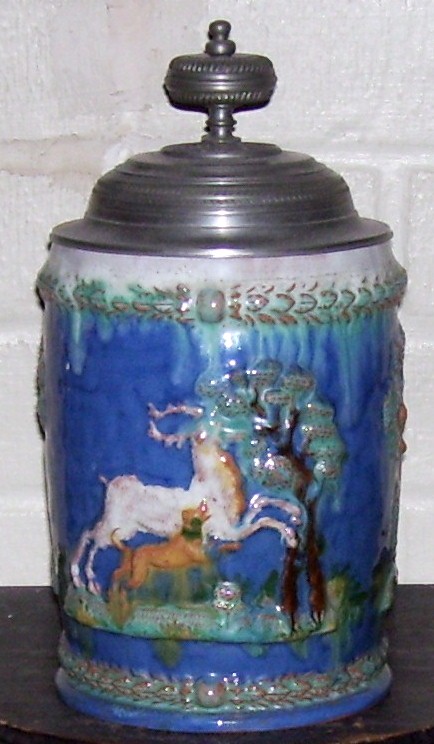
Majolica (“English Type” of Lead Glazing) Drinking Vessels from “The Münchner Werkstätten für Keramische Kunst (The Munich Workshop for Pottery Artwork),”
Editor’s note: these MAY be my assigned numbers they are not out of any catalog as I have never seen or even heard of one. STILL = Products of the Münchener Werkstätten für keramische Kunst, Munich, Bavaria Germany, (Kunst-Töpferei / Art Pottery.) Known dates: 1880’s – 1912,. Founded by Joseph & Karl Leipfinger.…
-
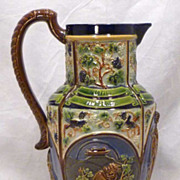
Majolica Beer Steins (Mostly German & Austrian), And a Few Habnerware (Hafnerware)
A great pair of majolica statues with a drinking theme. 25.5 inches high, to the top of the landsknecht’s feather. He should be holding a wooden halberd or lance with his left hand, most often missing. Probably Austrian. Circa 1870. [FWTD] For more on Landsknechts see: http://www.steveonsteins.com/lansquenets-on-beer-steins-etc-started-10-30-xing-as-i-go Majolica may refer to: [1] Tin-glazed pottery – decorated…
-
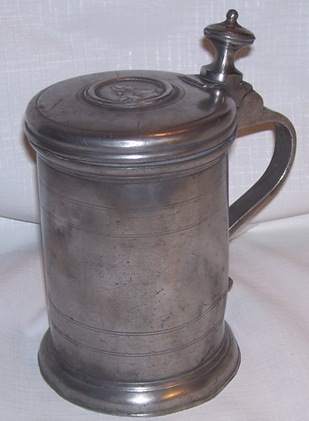
Pass Cups (2) – The “Pegged” Tankards
. A Norwegian “Peg Tankard (passing encouraged!) “Okay, now I’ll take you down a peg or two!” Expressions like this one are thought to have come from the playing of drinking games in the taverns of old (mostly North) Europe. The Baltic Sea area tankards / steins are famous for them and the…
-
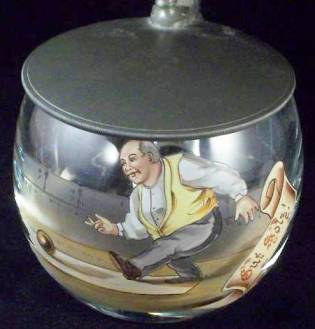
Kegels, the Predecessors to America’s 10 Pins: Gut-Heil / Gut-Holz and Pigs and Rats.
“GOOD WOOD” and “HOORAY – ALL NINE” (THE PIN BOY DOESN’T COUNT!) In 1841 a law in Connecticut banned “ninepin bowling” lanes due to associated gambling and crime, and people were said to circumvent the letter of the prohibition by adding an extra pin, resulting in the US game of “ten-pin bowling!” PER WICKOPEDIA: In…
-
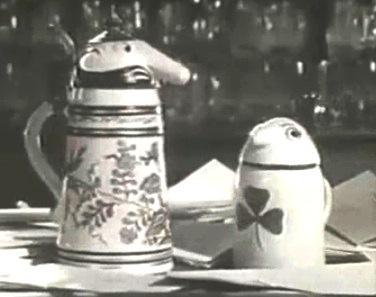
Guest writer’s articles: “West End Brewing Company / Utica Club Beer Steins ” – by John Manning and Dennis Hunsicker
Schultz and Dooley on television. Editor’s note: All photo credits on this page go to Dennis Hunsicker and John Manning, from their collection. A really great job, and these were easy for me to work with! Utica Club is a pale ale lager first introduced by the West End Brewing Company in 1888. Still sold…
-
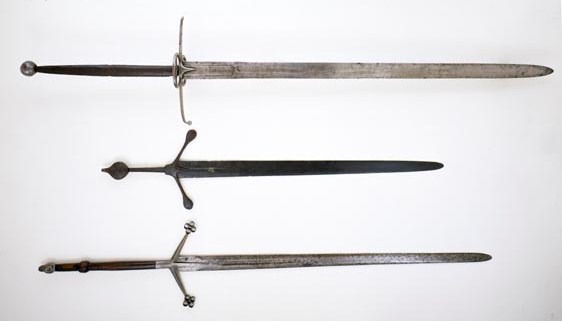
Guest writer’s articles: “How to Catch the Collecting Virus from an Innocent Ad.” – by Doug Bandow
It has been more than two decades since I turned from a collector into “A Collector.” How my life changed because of a little ad in a freebie county paper. My father was in the Air Force and my family spent my high school years in Great Britain. My parents collected antiques—quite plentiful in Britain…
-
![Guest writer’s articles: “Identifing Faience Steins [Part 1]: Comparisons of North German / South German Fayence Steins” – by William Hamer](https://www.steveonsteins.com/wp-content/uploads/2013/06/BH8END-2-RDY.jpg)
Guest writer’s articles: “Identifing Faience Steins [Part 1]: Comparisons of North German / South German Fayence Steins” – by William Hamer
Note: This article and all the others in this series were originally published in “PROSIT,” the magazine of Stein Collector’s International. Used with permission of the author Bill Hamer, a long term good friend of mine; and from Ron Fox, the editor of “PROSIT.” Identifying Faience Steins (Part 1) – Comparisons of North German /…
-
![Guest writer’s articles: “Identifing Faience Steins [Part 3]: “Rheinsberg Fayence (Germ.) Beer Steins” – by William Hamer](https://www.steveonsteins.com/wp-content/uploads/2012/01/Figure-1-part-3.jpg)
Guest writer’s articles: “Identifing Faience Steins [Part 3]: “Rheinsberg Fayence (Germ.) Beer Steins” – by William Hamer
Note: This article and all the others in this series were originally published in “PROSIT,” the magazine of Stein Collector’s International. Used with permission of the author Bill Hamer, a long term good friend of mine; and from Ron Fox, the editor of “PROSIT.” Identifying Faience Steins – Part 3, Rheinsberg Fayence Beer Steins. (1762-1866)…
Got any book recommendations?
